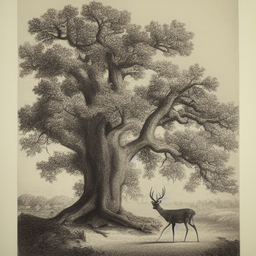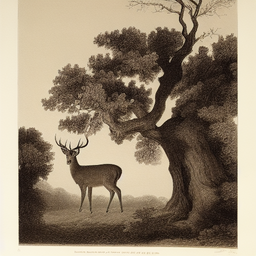About
Android, Linux, FLOSS etc.
Code
My code
Subscribe
Subscribe to a syndicated RSS feed of my blog.
Thu, 13 Oct 2022
On August 31st, Stable Diffusion was released. It is a computer program where you tell it what image to create and it creates it. So you say "tree" and it will give you a picture of a tree. You say "oak tree" and it will give you a picture of an oak tree. You say "oil painting of an oak tree" and you will get an oil painting of an oak tree. You say "lithograph of an oak tree" and you will get a lithograph of an oak tree. You can say "lithograph of an oak tree and a deer" and get this -

You can ask for it to give you some alternatives, in which case you can also get another try at it like

It is pretty simple to use - you tell it what image you want to see and it will attempt to give you that image.
It can do other things as well - if you like part of a picture it draws, but not another part, you can erase the part you don't like ("inpainting") and tell it to try something else. If you like a picture but want to see the surrounding envisioned scenery, you can ask for that as well ("outpainting"). If you give a text prompt and ask for some alternative pictures, and like one particular one, you can ask to make more pictures to look like that one. You can also do all of these things - inpainting, outpainting, image-to-image - with already existing pictures it did not create.
Stable Diffusion was released for free, and the source of the software is available (as are the pre-trained weights of its model). I am running it on my desktop at home. It can be run on a server on the Internet as well (hopefully one that has one or more GPUs).
Programs like this have been developed by other places in the past two years - DALL-E by OpenAI, Imagen by Google, Midjourney. There has been some limited access to them as well, although sometimes only by invite. Stable Diffusion just dropped this so that everyone can use it, and I am sure it will speed the adoption of deep learning.
AI
To go a little back into the history of all of this - in 1956 John McCarthy, Marvin Minsky, Claude Shannon and Nathaniel Rochester held a workshop on "artificial intelligence" for a study - "The study is to proceed on the basis of the conjecture that every aspect of learning or any other feature of intelligence can in principle be so precisely described that a machine can be made to simulate it."
Around this time, two schools of thought arose on how to do artificial intelligence - symbolic AI and connectionist AI. One idea in symbolic AI is that there are facts, and with a set of facts, one can use logic to come to conclusions. Symbolic AI is fairly understandable - you can understand and explain how a computer reasoned about something.The other school of thought in AI was connectionism. The idea in connectionism was to model the computer on the human brain - our brain is neurons which are connected, and connectionist AI created artifical neurons and wired them together. Connectionism has a focus on learning - data is sent through the neural network, and can be "remembered" later. Stable Diffusion is more in the connectionist school, which is the machine learning, deep learning school.
The connectionist school had some successes in the early days, but the 1969 book Perceptrons pointed out flaws in some things being done back then, which may have caused interest in connectionism to wane somewhat, and the success of some GOFAI type expert systems in the 1980s also favored that school over connectionism. However for the past ten years the connectionist deep learning school has seen a resurgence, and is in use at most of the big tech companies, and Stable Diffusion is part of this trend.
Stable Diffusion
Stable Diffusion uses a model to do what it does, and it cost about half a million dollars to train this model. The model is 4 gigs large on my computer, and it's amazing what can I can generate on my home computer with that 4 gig model. It's truly mind-blowing, and gives some insight into how the brain works and what computers will be able to do in the future. Stable Diffusion generates a lot of great stuff, but has trouble trying to generate some things (like a sign that says "WARNING" or something like that, or human faces in some cases). As time goes on, it an other systems will just get better.
You can download Stable Diffusion to your computer, but I know what I'm doing and had some difficulty getting it working. People are at work to make it simpler to do. You do need a decent graphics card. There are also forks of Stable Diffusion which may be simpler to install, or offer more features. If you think you can handle it, you can get Stable Diffusion here.
Probably easier is to just go to a website that takes text prompts and generates images, like Stable Diffusion web Dezgo Night cafe